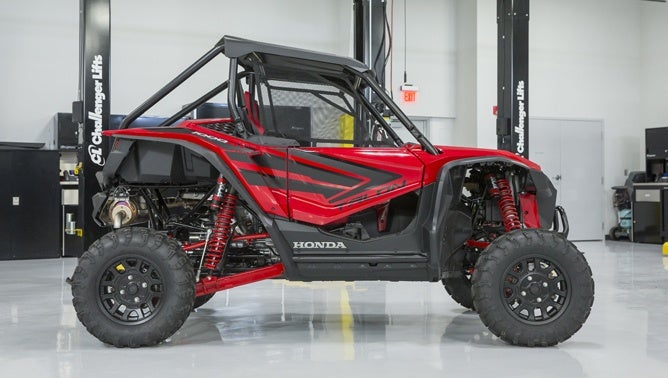We are saying this a lot these days, but the UTV market is growing at an unprecedented rate.
And, with more manufacturer support than ever before, it is only natural that Honda got into the sport UTV game. They identified this market as the fastest growing segment in powersports right now, and the Honda Talon seems to be coming into the 1000-cc, naturally aspirated foray at the correct time.
Some of you will say that Honda should have released a sport side-by-side years ago, but Honda is one of those companies that do their due diligence to make sure any machine with the wings on is going to be reliable, durable in any terrain, and properly equipped to take on any challenge. So, when we attended the official unveiling of the Talon, we weren’t surprised to hear that the engineers had spent countless hours and literally years developing this machine to make sure it was not only durable but it also was able to perform at a very high level for hours upon hours at a time.
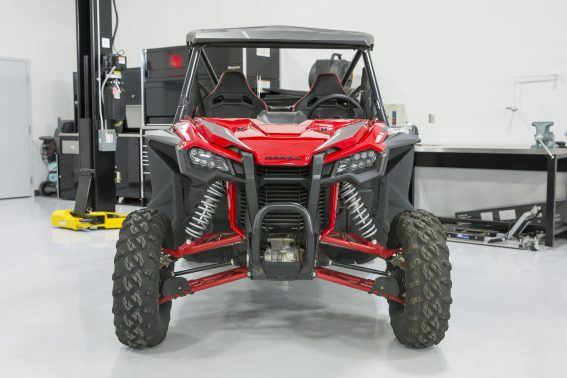
While we didn’t get to drive this machine yet (we’ll have to wait until next year to do so…), we did get a chance to sit in the Talon and get a feel for what this machine will be like.
ALSO SEE: Off-Road.com’s 2018 Best UTVs of the Year
Essentially, the Honda Talon is a 1000-class, naturally aspirated machine. The powertrain is adapted from the Pioneer 1000 lineup, but both the engine and transmission have received specific upgrades to make them more sporty in every way. The engine has 104 horsepower coming from the 999cc parallel twin, which is also EFI-controlled and has a 270-degree firing angle to ensure that it has a proper rumble coming from the exhaust. Both the exhaust and intake have been tuned to release a signature sound, giving the Talon a pretty good grunt from idle all the way to redline.
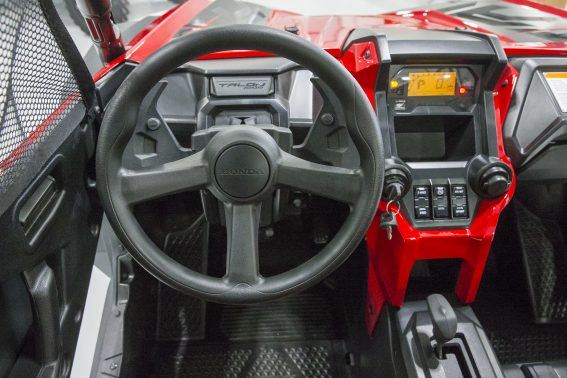
The transmission, which is a dual clutch (DCT) unit without any belt in any place, is said to deliver 50% faster shifts compared to the similar unit in the Pioneer. Compared to the Pioneer, this Talon DCT has an 18% lower reverse gear ratio. One of the most appreciated features of the Talon will undoubtedly be the fact that this transmission has a fully automatic mode in addition to the manual operation via paddle shifters. Unlike its closest competitor in the Yamaha YXZ1000R, the Talon will have this “lazy day” mode with the automatic feature. This isn’t to say that we don’t like the YXZ1000R, but some people don’t want to shift every time they take their side-by-side out on the trail, and the Honda Talon solves the issue that some buyers have always complained about on the YXZ.
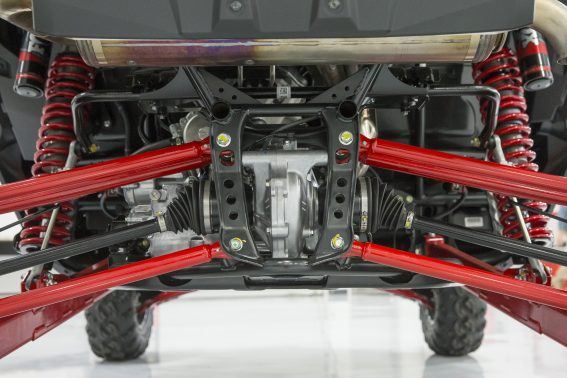
Unique to the Talon lineup, this Honda will be available in two models at launch – the 68.4” wide 1000R and the 64” wide 1000X. The 1000X model prioritizes trail riding and super handling characteristics through that type of tight and technical terrain. With less wheel travel (14.6” front and 15.1” rear) and a more compact wheelbase at 87.6”, this a-arm front and 3-link-equipped rear suspension will be less suited to the big desert bumps and more suited to that type of technical riding on the trails.
Never fear, because all of the desert riders out there (that includes us!) will immediately pass by the 1000X in favor of the wider 1000R model. Not only is the 1000R a little over 4 inches wider, but it is also slightly longer with a 92.7” wheelbase and has a 4+ link rear suspension that is quite the engineering marvel. It’s basically a trailing arm setup similar to what you’d find on Polaris RZR and Can-Am Maverick X3 vehicles, but this one has an additional upper link coming from the front trailing arm area that should provide more strength and stability. With 17.7” inches of travel up front on the dual a-arms, that slick rear setup has a healthy 20.1” of vertical movement.
No matter which model you choose, both the 1000X and the 1000R have dual rate spring-equipped Fox shocks. Both setups have QS3 3-position compression adjustment, but the 1000R has slightly better units because both the front and rear shocks feature crossover adjustment, which allows the driver to precisely tune their suspension for a variety of terrain. It looks as if Fox was given the freedom to truly put a good spring setup on these shocks as well, but we’ll have to wait to test them out in some desert terrain before we give them the nod of approval.
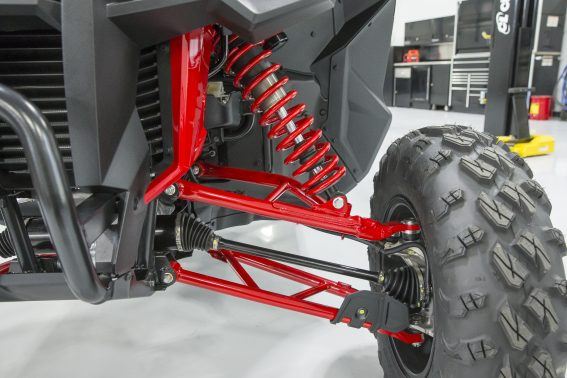
Other standout features include the one-piece chassis and the brakes, which look to be up to the task of wrangling down the speeds of this Talon to a halt. 250mm brake discs are found front and rear with two-piston front and single piston rear calipers. Hill start assist will also be a welcomed feature on up to 60% grades. If you find yourself on a grade that steep, you’re likely going to be engaging the on-the-fly I-4WD system. This operates like a traditional 4WD system in the sense that the rear diff is always locked and the front diff is a non-fully locking unit. However, Honda essentially developed an electronic system that mimics a locking front differential without putting a fully locking unit up front. The system’s software controls the traction electronically with the I-4WD system by sensing wheel slip and automatically routing power to the wheel with traction by modulating the brakes on the slipping wheel.
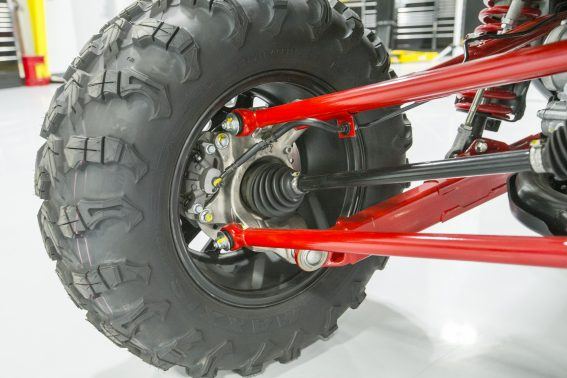
Those are the big items that set this machine apart from the pack of other 1000-class machines. The interior is fairly standard in the sense that the Talon has half doors, a well laid out but basic dash and glove box area, and foot wells that should provide great bracing places for your feet. The seats in the Talon are carved out to contour your body, and after sitting in the vehicle, I can definitely say that their mission of hugging your body was accomplished. I might go as far to say that these are right up there with the X3 stock seats at being the best in the industry. And, like many units these days, the stock seats in the Talon accept 4-point harnesses right from the factory.
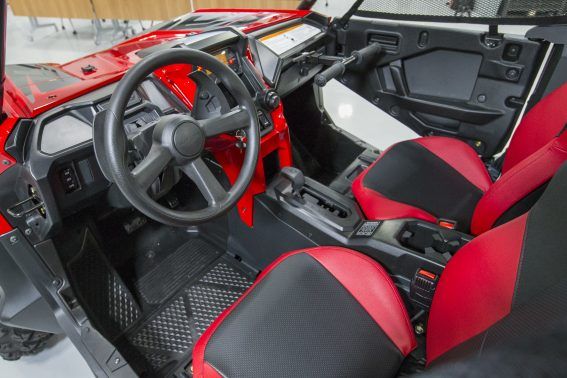
If you’re going to buy a Talon, don’t go a day without having 4-points in it for increased safety and security. As of note, the stock half doors are very well made on the Talon with built-in armrests and a secure latching system. They aren’t full half doors like some other stock vehicles on the market, but they do the job. Also of note is the significant storage box in the back of the Talon, which has 6 d-ring welded hooks in it to secure your gear. It’s large and well built, just like it should be.
So, you’ve seen the Talon and what this vehicle is all about, but how does it compare to some of the other notable 1000-class competitors already on the market? Well, let’s see…
Honda Talon vs Yamaha YXZ1000R
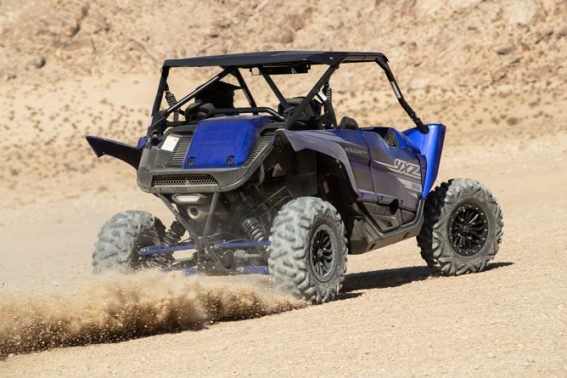
This comparison has to be first, not because Honda finally has a competitor to the Yamaha sport side-by-side, but because these two vehicles are the most closely matched. The Yamaha was the first mass-produced side-by-side with a manual transmission, and the Talon is just the second mass marketed unit to have manual shifting capabilities instead of a belt-driven CVT. The Yamaha wins the transmission category if you’re looking for options – the YXZ is available in both full manual and paddle-shifted auto clutch (SS) versions. Where the Talon one-ups the YXZ is with the fact that it has a fully automatic mode. Buyer’s who didn’t want to shift the YXZ every single time they got into the vehicle will rejoice in the fact that the Talon has that fully automatic mode. That’s not to say that you won’t be able to jump on the Talon’s throttle though as the paddle-shifted mode should be plenty spirited for most drivers.
Both machines feature similar interiors. The Yamaha has a dash connected to the steering wheel column, giving it a more race-oriented and easier to quickly read setup. Storage is similar in both vehicles, but the Honda has better seats stock for stock with more upper lateral support than the Yamaha. Looking out from the front, the Yamaha has always had amazing sightlines right in front of the vehicle, and from our quick sit-in experience, the Talon doesn’t have the sloped fenders that we have come to love in the Yami.
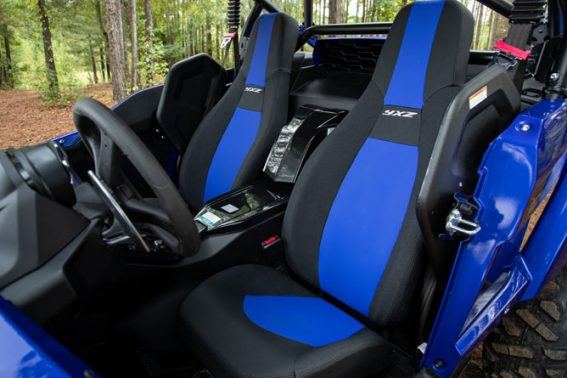
Chassis-wise, the 1000R has a slightly longer wheelbase than the YXZ (90.5”), and it also has more suspension travel by several inches both front and rear. The 1000X is a more apples-to-apples comparison here, and we see that the YXZ has a longer wheelbase compared to the Talon and more wheel travel at the same width.
ALSO SEE: 2019 Yamaha YXZ1000R SS Review: Trail and Desert Ride
Both the Talon and the YXZ are built to last, as you’d expect from the Japanese manufacturers. The Talon has a bit more rear cargo storage space than the Yamaha this year because of the YXZ’s radiator relocation to the rear, but the YXZ has been refined and dialed in over time. Overall, this matchup should prove to be one of the best in the 1000-class.
Honda Talon vs Textron Off Road Wildcat XX
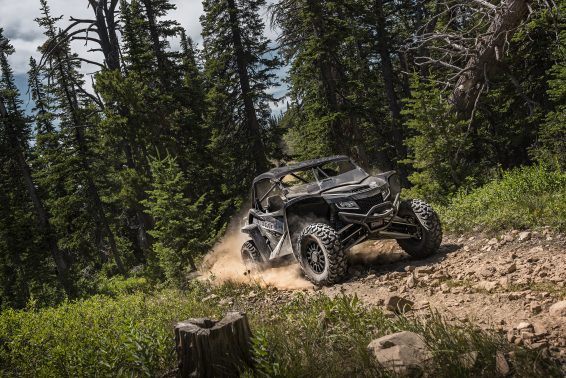
If the Yamaha vs Honda debate was all about powertrain performance with those manual transmissions, the Honda vs Wildcat XX debate will more heavily focus on the suspension systems that are similar, yet so different. The different parts are confined to the fact that the Wildcat XX is a trailing arm setup and the Talon 1000R, which is the better direct competitor to the XX suspension wise, is a 4+ link-style setup. Where these machines are very similar lies in the fact that they both use the same QS3 compression adjustable Fox shocks with almost identical spring setups – both are dual rates setups with crossover adjustments. Both have similar travel numbers. As you have read elsewhere on Off-Road.com, the Wildcat XX is absolutely the best stock suspension on the market right now in a 1000-class machine, and the Honda Talon 1000R engineers touted that machine as one that could easily take on the nastiest whoop sections in the desert. So, let the battle of the suspensions begin…
ALSO SEE: 2019 Textron Wildcat XX Review
Besides the suspension debate, the Wildcat XX uses the Yamaha YXZ engine, which puts out 130 horsepower this year, a full 26 more than the Talon. With a CVT transmission, will the XX be able to have the durability of the proven Talon DCT? We’ll have to wait and see.
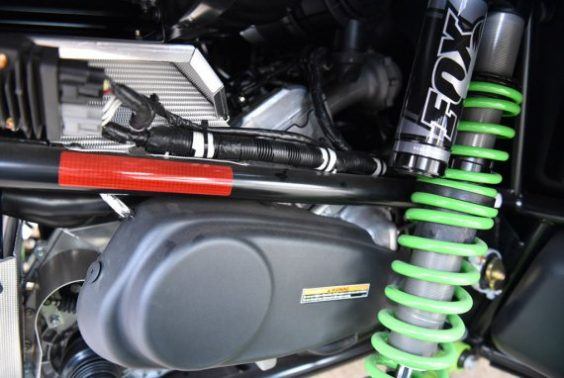
When we look at the interiors of each, the doors on the XX will win every time because they offer full protection, but after using the Talon’s doors, they are going to be hard to beat for durability and ease of use over time. The seats of the Talon are so much better than the XX seats, stock for stock. However, the XX has some really good features built into the interior that the Talon lacks, such as a dedicated mounting spot for your iPad, a massive glove box, and more accessory switch spots.
Honda Talon vs Polaris RZR XP 1000
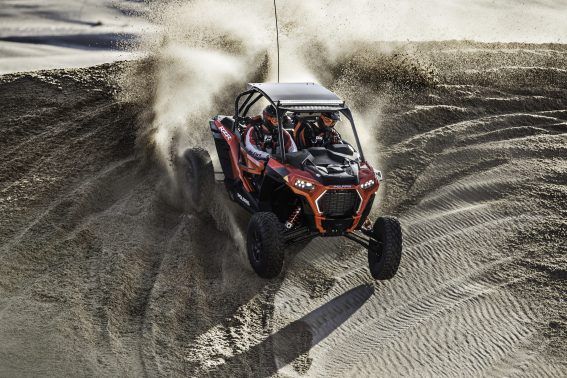
The side-by-side by which essentially all other side-by-sides are compared with is the longtime bestseller RZR XP 1000. This vehicle is the one that really took the RZR brand to the next level in 2014 when it was introduced. Before the Turbo models, the XP 1000 was and still is the king of diversity. The chassis measures out to be 64” wide, just like the 1000X, and it includes a 110 horsepower parallel twin cylinder engine. The layout of the engines from both machines is similar, but the Polaris edges out the Honda by a mere 6 horsepower. However, the Talon has a more direct drive transmission unit in the DCT rather than the belt-driven CVT unit found in the Polaris.
ALSO SEE: Review: Tackling the Mud in a High Lifter Polaris RZR and Ranger
On the inside, the Talon is definitely more refined than the RZR with better fit and finish and much better seats than the stock RZR.
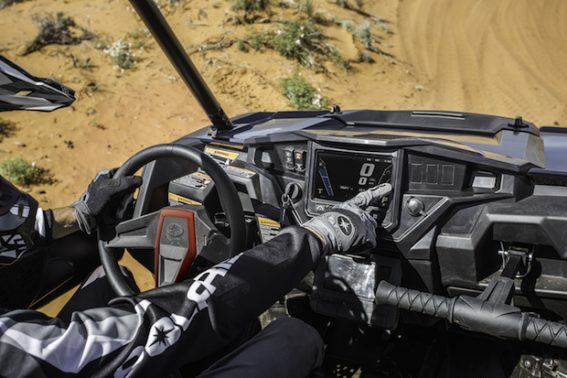
Personally, I have always measured chassis driving dynamics from other vehicles to the Polaris RZR, and there is a good reason for that. The RZR chassis is very dynamic in the sense that it has a very controllable, flickable personality to it, which makes the RZR fun to drive going pretty much any speed. What most people don’t realize is that the RZR chassis has a menacing side to it that only opens up at high speeds with technical, fast-paced driving. By menacing, I mean amazing because the chassis really comes to life the harder you push it. Most people won’t ever test that limit, but we have found similar driving dynamics in vehicles like the Yamaha YXZ. Both models of the Honda Talon should have these similar driving dynamics where it will be confident and fun to drive at pretty much any speed, and then the driver’s who want to push the machine further than normal will be rewarded with a balanced chassis fit for those higher speeds and challenging driving. We sure hope the Talon delivers.
Honda Talon vs. Can-Am Maverick X3 lineup
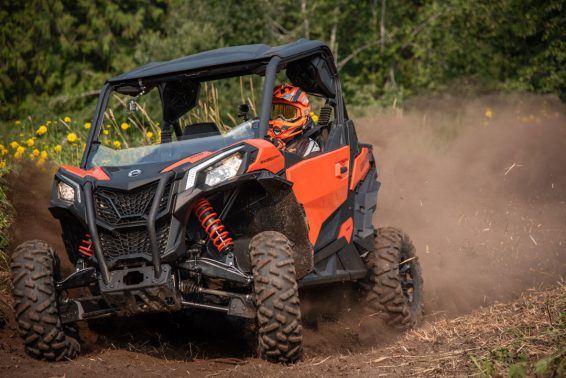
Saving arguably the most interesting debate for last, we could say that the Talon doesn’t directly compete with any vehicle in the Maverick X3 lineup because the Talon doesn’t have a Turbo model (Honda stated that the aftermarket is responsible for any Turbo applications), yet this statement would be incorrect because the X3 can’t be left out of this debate. It is one of the top-selling sport side-by-sides on the market today, and the Talon will be vying for those customers.
ALSO SEE: 2019 Can-Am Maverick Sport Review
Specs alone will tell you that these machines are very different – the X3 has a Turbo-equipped 3-cylinder engine, a CVT transmission on all models, and no less than a 102” wheelbase and 120 horsepower in the base Turbo model. However, even if the Talon lacks in specs, it can catch the X3 in driving and handling refinement. That’s not to say the X3 handles poorly in any fashion, but the chassis could use improvement in several areas, areas that Honda is known to be great in.
Conclusion
For more conclusive information on the driving dynamics of the Honda Talon 1000X and 1000R, we’ll have to wait to get behind the wheel in the near future. We know that Honda engineers weren’t leaving anything to chance on this vehicle – they delivered a properly equipped sport side-by-side that has all of the right features to make it a top seller in the industry. We’re just glad to see Honda finally jump into the game with the Talon, and we look forward to what they have coming next…
Discuss this article our Honda Talon Forum
